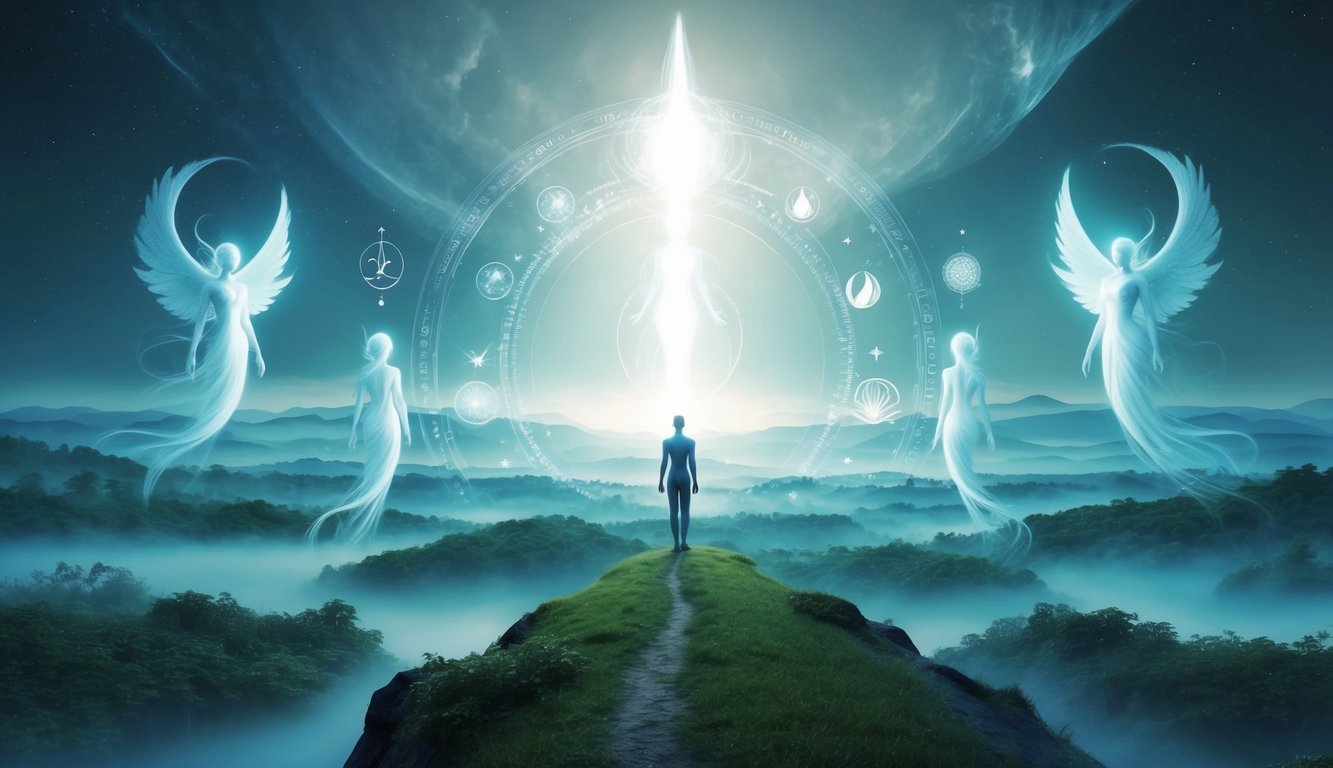PsychNewsDaily Publishers
100 Summit Drive
Burlington, MA, 01803
Telephone: (320) 349-2484
PsychNewsDaily Publishers
100 Summit Drive
Burlington, MA, 01803
Telephone: (320) 349-2484
The spiritual realm encompasses non-physical dimensions where spirits, souls, and deities exist, influencing human experiences and beliefs across various cultures and religions.

Many people wonder about the meaning of the spiritual realm and how it connects to their lives. The spiritual realm refers to a reality beyond the physical world, where non-physical beings like spirits exist. This realm is often seen as a space where individuals can connect with something greater than themselves, whether that be a higher power, the universe, or the essence of their own spirituality.

In various belief systems, the spiritual realm is believed to influence daily life and personal experiences. Some view it as a place inhabited by both benevolent and malevolent spirits. For others, it represents a deeper understanding of life, death, and the connections between all living beings.
Exploring the spiritual realm can enrich a person’s life and lead to a greater sense of purpose and understanding.
As more people seek to understand their place in the universe, the spiritual realm becomes increasingly relevant. By examining its meaning, individuals can learn more about their beliefs, enhance their spirituality, and navigate the complexities of the reality they live in.

The spiritual realm consists of beliefs and concepts that explain life beyond the physical world. It includes various elements, such as souls, spirits, and deities, which have shaped human understanding of existence and the afterlife.
The spiritual realm refers to a dimension beyond the tangible world. Many believe it to be the home of the soul after death. In this realm, spirits, such as angels and demons, may exist. The concept also often involves interactions between these entities and the human experience. While specific definitions can vary, the essence remains consistent across many cultures.
Different cultures have varying beliefs about the spiritual realm. In many religions, spirits can influence daily life, decisions, and nature. For example, in Christianity, spirits and angels serve God and assist believers. In other traditions, like spiritualism, spirits of the deceased communicate with the living.
Here are a few common beliefs:
Each culture adds unique traditions and practices related to these beliefs.
The spiritual and physical realms are often seen as interconnected. The physical realm is where people experience life, while the spiritual realm houses the soul and divine entities. Events in the physical world may be influenced by spiritual forces, according to many traditions.
Key differences include:
By understanding these differences, individuals can appreciate the broader context of their beliefs.

Many people believe that interactions with the spiritual realm are an important part of life. These connections can include encounters with spiritual beings, the feelings they inspire, and how these experiences shape emotions and community.
Interactions with the spiritual realm often involve personal encounters. People may experience moments of connection during prayer or meditation. Some report visions or messages that feel significant. These experiences can ignite feelings of hope or wonder. They may also evoke fear, particularly when the experience feels unsettling.
Ghosts and spirits are often seen as bridges to this realm. People tell stories of encounters with loved ones who have passed away. Such meetings can bring comfort, showing that bonds continue even after death. Historical accounts and documented cases lend authenticity to these experiences, making them relatable to many.
The spiritual realm is believed to be populated by various beings. Angels are often viewed as guides, bringing messages and protection. They are seen as benevolent forces that help during times of need. In contrast, demons may represent fear or obstacles to overcome in life.
Some believe that individuals can also experience spiritual warfare. This involves battling negative forces that can affect their well-being. Communities may come together for exorcism, seeking help to rid spaces of unwanted spirits. These practices can strengthen communal ties as people unite for a common purpose.
Interactions with the spiritual realm can deeply impact human emotions. Joy, fear, and serenity are common feelings experienced during these encounters. Many find comfort in spirituality, especially during tough times. It can also inspire a sense of belonging in community with shared beliefs.
Through worship and prayer, individuals often seek strength and connection, fostering emotional well-being. The emotions stirred by these spiritual interactions can encourage growth and reflection. They help shape how people view their lives and the world around them.

Spirituality often comes to life through personal beliefs, community connections, and the guidance of religious texts. These aspects help individuals find purpose, peace, and a deeper understanding of their faith.
Personal beliefs shape how individuals connect to spirituality. Many people draw from their life experiences and feelings to define what spirituality means to them. This can include practices like prayer, meditation, or mindfulness.
During spiritual moments, some may feel a profound sense of grace or an inner peace. Reflecting on personal stories can strengthen one’s beliefs and lead to a greater sense of purpose.
These personal experiences are unique, often guiding individuals on their spiritual path. They can inspire one to explore deeper meanings in life and strengthen their commitment to their beliefs.
Community plays an essential role in spirituality. Many find support and encouragement among like-minded individuals or groups. Being part of a church or spiritual community can enhance one’s journey.
Shared faith fosters connections through worship, group prayers, and joint activities. These gatherings are opportunities for believers to express their beliefs together. Traditions within these communities also provide a sense of belonging.
Additionally, communities can facilitate service and outreach projects. This shared activity can deepen relationships among members and extend their faith beyond personal beliefs.
Religious texts often serve as guides for spiritual practices. They contain teachings and stories that offer insight and wisdom. For many, reading scriptures is an essential part of their spiritual routine.
Rituals, such as lighting candles, singing hymns, or celebrating religious holidays, help bring the teachings to life. These practices can create a sense of harmony and peace.
Engaging with these texts and rituals allows individuals to connect with spiritual authority and tradition. It provides a way to explore the values and lessons that have been passed down through generations, enhancing one’s spiritual journey.

This section addresses common questions about the spiritual realm, its meanings, and beliefs related to it. Understanding these aspects can enhance one’s perspective on spiritual experiences and interpretations.
In the Bible, the spiritual realm refers to a dimension where God, angels, and spiritual beings exist. It contrasts with the physical world and is often seen as a place of divine activity. The Bible suggests that the spiritual realm can influence the lives of people on Earth.
The idea of seven spiritual realms varies among different teachings. Generally, these realms may include levels like the celestial realm, where God resides, and other layers associated with angels and spirits. Each realm often symbolizes different aspects of spiritual growth and enlightenment.
People may use practices like meditation, prayer, and rituals to access the spiritual realm. Some believe that certain spiritual guides or mentors can help them connect with this dimension. Dreams and visions are also thought to provide glimpses into the spiritual world.
Many traditions suggest that the spiritual realm operates under laws such as karma or divine justice. These laws explain how actions influence spiritual consequences. Different belief systems may have unique interpretations of these principles, guiding followers on their spiritual journeys.
The spiritual realm is often viewed as eternal and unchanging, while the physical realm is temporary and constantly changing. The spiritual realm focuses on the unseen aspects of existence, such as faith and inner growth. Philosophically, this distinction helps explore deeper questions about life and existence.
The spiritual realm is believed to be home to various entities, including angels, spirits, and sometimes demons. In many beliefs, these beings can influence human lives positively or negatively. Each entity is thought to have its purpose and role in the spiritual order.